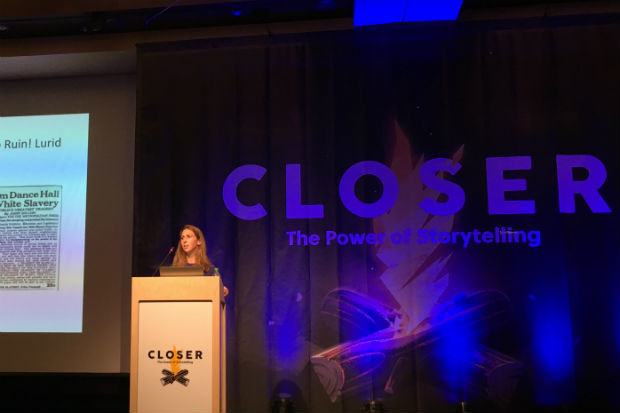Great storytelling can bridge the gaps between the experiences that we have lived ourselves and those we only know because others have shared them with us.
Sarah Stillman, staff writer at The New Yorker and director of the Global Migration Program at Columbia University’s Graduate School of Journalism, covers the “disposable people beat”.
Her aim is to “tell the stories of the people who were told that they’re disposable, and insist that they’re not,” she explained, speaking at the Power of Storytelling conference in Romania today (20 October).
But how can you tell the “story behind the story” and cover this beat without “cannibalising the worst moments of somebody’s life”?
“I get lost in the work and lost in the question of how you can possibly have the audacity to try to tell stories about the trauma in the lives of others,” she said.
Stillman highlighted five mandates – or pep talks – she keeps in mind when finding, researching or telling these stories.
1. Train your eyes for the margins
One of the first stories that piqued Stillman’s interest was the story of Donna Julane Cooke, whose body was found while police were searching for a missing girl called Jessica.
Media organisations covering the story reported the discovery by focusing on the fact that the body found was not Jessica, rather than identifying the woman and the circumstances of her death.
The story stayed with Stillman, who called the police department and found out the name of the girl, Donna, and then more about her life.
By looking on the fringes of stories that are already dominating headlines, journalists with “radical curiosity” can find additional leads.
“How do you train your mind to look at the margins of the story? [It’s] one of the best possible skills to learn if you’re a journalist,” she said.
2. Don’t ask for permission first
Reporters, especially those at the beginning of their career, usually rely on feedback from their editors to determine whether a story should be covered.
But Stillman explained such support can be difficult to muster when telling the stories of the “not-Jessicas”, as “no one is going to tell you that your story actually matters”.
Another story Stillman uncovered by looking in a slightly different direction than the majority of journalists was the experience of third-country nationals (TCN’s) on American military bases, some 70,000 workers from countries such as India, Nepal, Bangladesh or Sierra Leone who were tasked with handling the logistics of day-to-day life for the American military in conflict zones.
Her reporting on this “invisible army” for The New Yorker included, for example, the experience of Vinnie, who worked as a hair stylist in Fiji and was offered a supposedly better paying job in Dubai, but instead ended up working in a beauty shop for a military base in Iraq.
She was able to cover this story not because she was the most experienced reporter in the room, she said, but because the others were focusing on the conflict itself, and she was “the one who showed up”.
3. Get granular and have a protagonist
Focusing on Vinnie's story about workers on military bases enabled Stillman to highlight a protagonist readers can root for, and who resonates with audiences all over the world.
“I changed the title of my talk to Storytelling and Radical Empathy - cause I feel that’s what the world needs most today” Stillman #story17
— Paulien Bakker (@Schrijfkracht) October 20, 2017
Her method also includes experiencing and telling the day-to-day moments that come up, such as somebody taking their child to school.
“So often as journalists we are told to look for the outlier… and we rarely think about the quieter moments. One of the things that anthropology teaches you is to value those moments.”
4. Look at the systemic issues
“We are so trained to look at individual stories that we forget to analyse where they overlap with systemic injustices,“ she added.
Her fourth mandate is to “pan back” and look at the bigger picture, rather than telling only the story of one person in one particular place, as this could make the issue easier to dismiss.
She pointed to her experience finding out more about Donna Julane Cooke, who was a confidential informant at the time of her death.
Researching the rules about confidential informants, Stillman found out that all across the US, there are stories of young offenders being offered deals to inform rather than be sent to jail.
She was able to write about young people in Washington State, Kentucky and Detroit, among others, who were killed working as informants.
Placing an individual story in its historical context is also an important part of the process, she said.
5. Get moving
Stillman takes the expression “walking in someone else’s shoes” as a very literal imperative.
She explained the advantages of “physically being there” and “simply showing up” as invoking a different form of listening that gets closer to the story the sources are living.
Free daily newsletter
If you like our news and feature articles, you can sign up to receive our free daily (Mon-Fri) email newsletter (mobile friendly).










